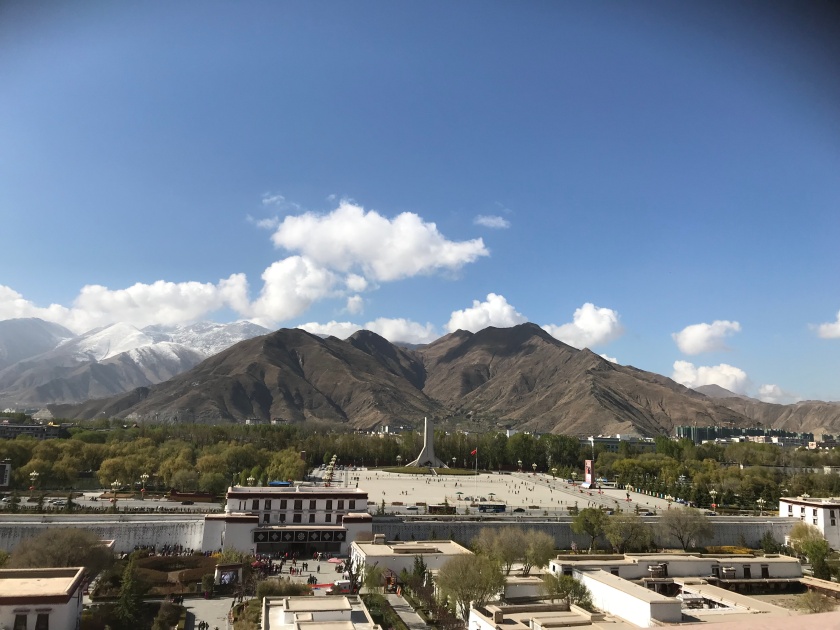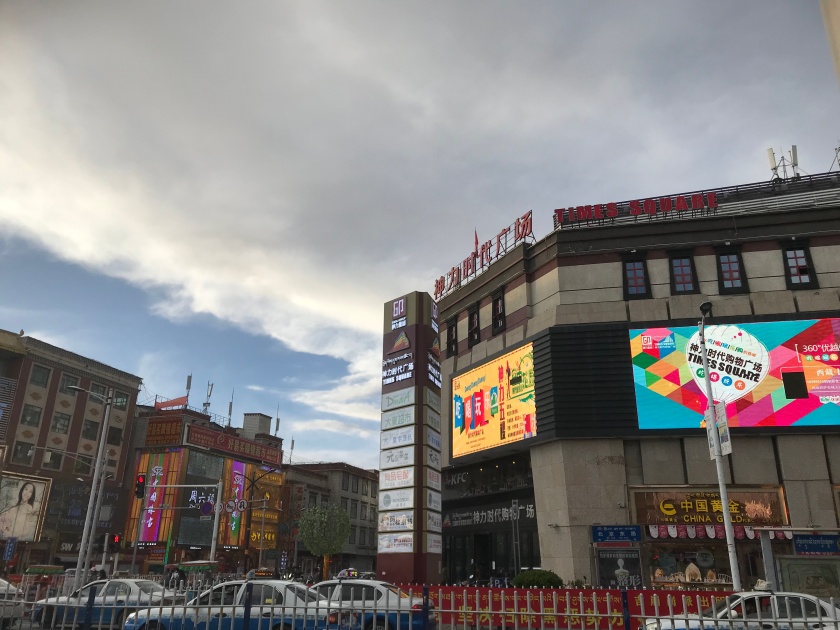Today was arguably the most important day of our Southern China and Tibet trip. We were going to see the Potala Palace and the Jokhang Temple, the two biggest cultural icons of Tibet.
0900: First thing after breakfast, we set off to see the Potala Palace. It wasn’t a long journey, as the Potato Palace is located in the centre of Lhasa only few kilometres from where we were staying.
Entry tickets to the Potala Palace needs to be booked the day before. Our tickets were arranged through our tour company. Entrance is at the Potala Palace square, right in the centre of Lhasa. There is an airport style security check at the entrance, and no liquids are allowed inside.

A little bit of history: The Potala Palace was built at the time of the Tibetan king Songstsan Gampo in the 7th century. The 5th Dalai Lama reconstructed the palace in the 17th century, and since then, it became the residence of the successive Dalai Lamas and the centre of the Tibet local government. The Potala Palace is designated as a World UNESCO heritage site, along with the nearby Jokhang temple.
We left visiting Potala Palace to our 3rd day in Lhasa. There’s a lot of climbing involved and delaying the visit until your body was acclimatised to the high altitude is a good idea.
The palace has 13 stories and mainly consists of living quarters, chapels, tombs, stupas and monk dormitories. The main construction is divided into two sections; the White Palace and the Red Palace.

After the security entrance, the climb to the White Palace starts. There are many steps, but thankfully, also places to stop and take a break. On the way, you get great views of Lhasa.

After climbing about 6 stories, you enter the White Palace. From this entry point, your visit is time limited. Each visitor is restricted to 1 hour inside the inner White Palace and the Red Palace. The ticket is time-stamped at the entrance and the exit to make sure that people stick to the time limit. From this point forward, there are no photos allowed either.

The upper part of the White Palace is the living chambers of the Dalai Lama and the lower parts are the offices of the former local government.
From the inner White Palace you enter the Red Palace, which was initially built to house the tomb of the 5th Dalai Lama. It subsequently housed the stupa tombs of successive Dalai Lamas.
No photos are allowed inside, but from memory it was a haze of red and gold, with hundreds of statues, yak butter lamps, monks chanting and people making offerings. I could have been in the 15th century except for the fact that most people (including the monks) had mobile phones (and a very good 4G signal). You can also see the residential quarters used by the 14th Dalai Lama, before he left Tibet.

After the Red Palace, you exit from the side gate. This exit gives you a great view of the palace and the mountain on top which it is built. The walls of the palace are wider at the base to make it steady and withstand earthquakes.

On the way down you also get some great views of central Lhasa.

After exiting the Potala Palace, we had a short break for lunch and then we travelled on to the nearby Jokhang Temple. Jokhang Temple is located in the nearby Bakhor Square and is one of the most important Tibetan temples.

1300: The Jokhang Temple was founded during the reign of King Songtsen Gampo, who also built the Potala Palace. According to historic record, the temple was built for the king’s two brides: Princess Wencheng of the Chinese Tang dynasty and Princess Bhrikuti of Nepal. The two Princesses are credited with introducing Buddhism to Tibet, and it is said that the temple was built to house the golden Buddha statues the princesses brought from their home countries.

Bakhor square is heavily guarded and there are security checkpoint at the entrance. Once through, you can see many devotees prostrating before the temple. We were told that most people in Lhasa, start their day with a clockwise walk, or a “Kora” around Jokhang temple.

Temple is decorated with many frescoes in the Nepali style and said to have been done by artists that came over with the Nepalese Princess Bhrikuti. The golden Buddha statue that the princess brought with her still reside the temple (but there is some debate about if this the original or a copy – the original having being lost in the sands of time).

Again, there are no photos allowed inside. The interiors were a similar to Potala Palace, except that there were fewer living quarters in this temple.

1600: After the Jokhang temple, we took a bit of time to walk around central Lhasa. Lhasa is a bustling city, but a lot smaller compared to other Chinese cities we had visited. You also see the a mixture of Chinese and Tibetian culture, from language, clothes to food.

One thing I noticed was that there were many stray dogs in town, many more so that we saw anywhere else in China. Although they were stray, they looked well cared for, and everyone we saw were very kindly towards them.


1900: We called it another early night, since tomorrow was to be an early start. We would be heading out of Lhasa tomorrow, towards Gyantse.
In my next post: We leave Lhasa behind and head to the mountains.
3 comments